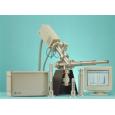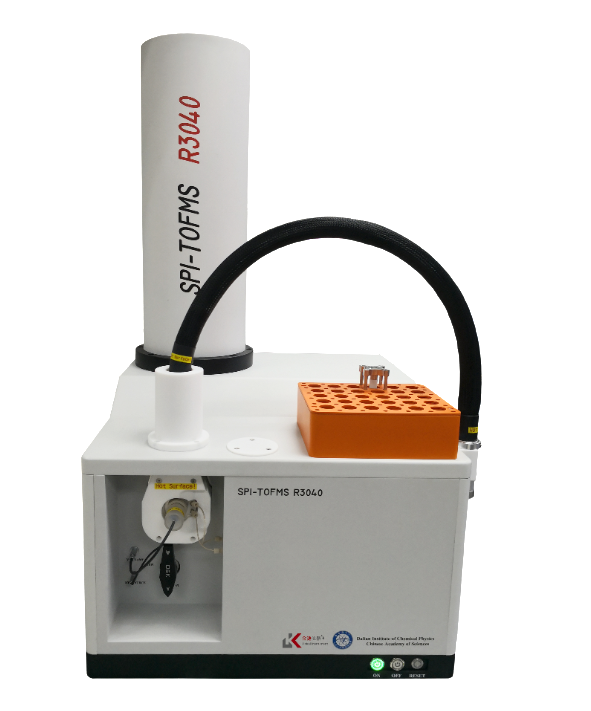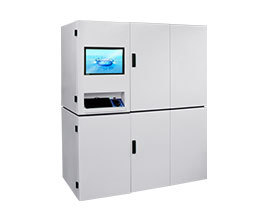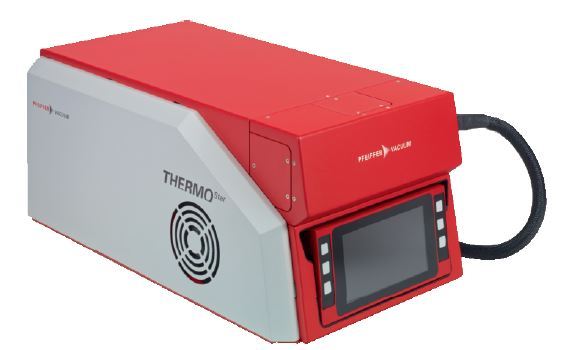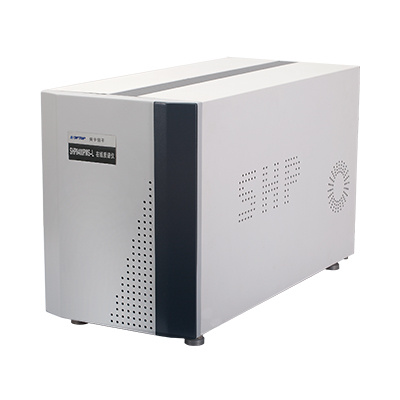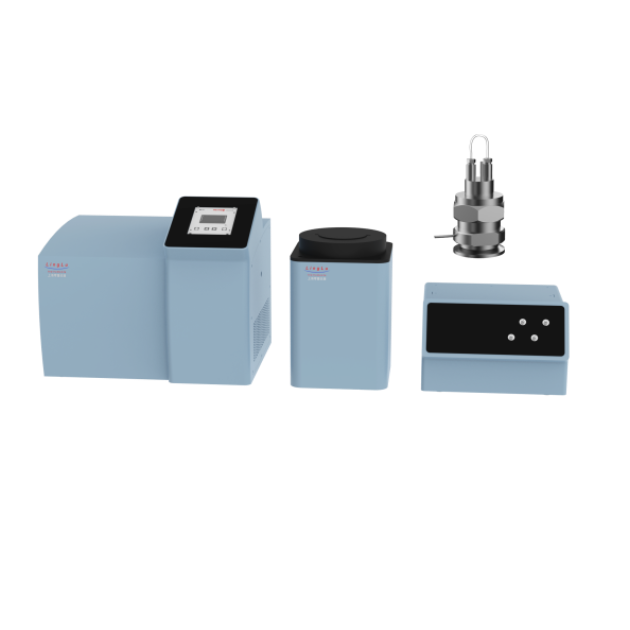方案详情
文
在相邻电极的脉冲电子束产生的氩和氧的等离子体中,测量时间分辨离子的流量和能量分布。氩离子和氧离子的能量和流量的时间变化,是跟等离子体的电子温度和离子密度相关的。氧等离子体的延迟时间要比氩的短。这可以通过分析各种离子的损失机理来推断。
方案详情

TIME-RESOLVED ION FLUX MEASUREMENTS IN...PHYSICAL REVIEW E 65 046412 PHYSICAL REVIEW E 65 046412S.G. WALTON et al. sionless sheath, the incident ion energy E; is determined bythe ion kinetic energy at the presheath-sheath boundaryE sand the potential drop across the sheath V, and is given by[14] where k is Boltzmann’s constant, M; is the ion mass, and m,is the electron mass. In separate experiments [11]. the steady-state T。 is found to be ≈1.0 eV in argon and ≈0.3 eV inoxygen. The maximum ion energies in the energy distribu-tions taken during the steady state (Fig. 2) agree with thesevalues according to Eq.(1). Possible causes for the spread inenergies below the maximum value are spatial and temporalvariations in T, and collisions within the sheath. The ion flux T, leaving the plasma can be expressed as[15] where ub=(kT/M;)is the Bohm velocity and n, is thenumber density at the presheath-sheath boundary which isassumed to be proportional to the bulk plasma density (n,=Ano)[16]. By correlating the ion energies and signal intensities withthe electron temperature and plasma density from Eqs. (1)and (2), we can infer a time-dependent description of theplasma. From the ion energies, the electron temperaturespikes early in time and then settles to a steady-state value.During this time, the ion flux and the plasma density build tosteady-state values. Once the beam is turned off, the electrontemperature and the plasma density decay. Similar behaviorhas been observed in other pulsed plasmas in oxygen [17]and argon [7,18] and is compatible with global models [i5jand simulations [19] employed to describe such plasmas. While the variations in the ion flux for oxygen and argonplasmas are qualitatively similar, the time scales differ. Thisis well illustrated in the total ion flux measurements (Fig.5)and in particular by the characteristic decay times of thesignal. The decay time for the Ar* signal is greater than thedecay times for both the O* and O2t, which differ as well.These differences may be understood in terms of the diffu-sion, electron-ion recombination, and charge exchange rates.Note that in these oxygen plasmas, the formation of negativeions is negligible [20] and so, unlike other electronegativeplasmas [15,21], negative ions have no impact on the plasmadecay. To understand the plasma decay, consider the evolution ofthe density n;(t) for a given ion species (i): where S is the gas ionization rate, k, is the electron-ionrecombination coefficient, k。 is the ion destruction coeffi-cient due to charge exchange, Dai is the ambipolar diffusionconstant, l is the source-electrode distance, n, is the neutraldensity, andn is the electron density. If the beam is turnedoff at t=0, Eq. (3) reduces to, where B=[keng+(Da;ll)]. For the dominant ion species,we can set n;=n, and then directly integrate Eq. (4) to ob-tain where nss=n;(0) is the steady-state plasma density. Thetime for n;(t) to drop by one e-fold is therefore In order to compute the decay time re, we need to ...deter-mine nss, k,, and B. The steady-state plasma density hasbeen measured under similar conditions [11] and was foundto be nss~10"’cm-3. The electron-ion recombination ratecoefficient is small for atomic ions [22] compared to that formolecular ions [23]: k~10-13 cm’s- for Art and O+versus k,~10-8cm’s- ifor O+. Magnetization of theplasma electrons reduces the ambipolar diffusion coefficient[24] to a value of D:~10’cm’s- for all ions of interestand it is assumed to be nearly constant over the time rangeconsidered. Considering only destructive charge exchangereactions and ignoring all interactions with impurities, thereaction of interest here (0*+0→0+0t) has a rate co-efficient [23] of ke~10-1cm’s-l. For Ar* and O+, k,T(02*)>r(O*)..The differences be-tween the calculated and measured values are presumablydue to the estimates and approximations used. In argon, forexample, using diffusioncoefficient1t ofDa~3×10’cm’s-l in Eq.(9) would give better agreement withthe observed decay. We have also assumed a constant elec-tron temperature, which impacts the diffusion coefficients inboth plasmas and the electron-ion recombination rate in theoxygen plasma. Nonetheless, the results are useful in under-standing how the various reactions influence the plasmadecay. ( [ 1 ] See , f o r e x a m pl e , N . I t aga k i, A . F uku d a, T . Y o shizaw a , M . Sh i n d o , Y.Ueda , an d Y . Kaw a i , Surf. C o at. Te c hn ol . 1 3 1 , 54 ( 2 0 00) . ) ( [2] S ee, f o r ex ample ,S. Sa m uk aw a an d T. M i e no , P la sma So u r c e s S c i. Tec hn o l . 5 , 132( 1 99 6 ). ) ( [3 ] L a w r e nce J . O v erz et a n d F o o n g Y i n g Leo n g-Ro u sey, P l a s maS o u r ces S c i. T ech n ol. 4 , 432 ( 1 99 5 ). ) ( [ 4] T . Mi e n o a nd S. Sa m u k a wa , Plas ma S our c e s Sc i . T e ch n o l . 6 , 39 8 (1 9 9 5 ) . ) ( [5] C . C h a r les a nd R . W . Boswe l l , J . Ap pl. P h y s.78, 76 6 ( 1 9 9 5). ) ( [6] M . B a e v a, X. L u o , B. P f e l z e r , T. R e psilb e r, a n d J . U h l en bu s c h, P la sm a S ourc e s Sci. T e c hn o l . 9 , 128 (2 0 0 0 ). ) ( [71O. Z a be i da, A . H al l il , M . R. W e rt h e i m er , an d L . M ar t i nu , J . App l . Phys. 88, 6 35 (2000 ) . ) ( [ 8] W . M. Manh e im e r , R . F . F ernsler, M. L am p e , a n d R . A . Me ge r,P la s m a S o u r c es Sc i . T e chn ol . 9 , 3 7 0 (200 0 ). ) ( [ 9 ] R . F . Fe rn s l er , W . M . Ma n h e i me r , R . A. M eg e r, J . Mathew, D .P . M u r p h y, R . E . P e c h ac ek , and J . A . G r e g o r, P hys . Pl a smas 5 , 2137 (1 998). ) ( [ 1 0 ] M . J . K u s hn er , W . Z . C o l li s on, a n d D . N. R u z i c , J . V a c . Sc i .Techn o l.A 1 4 , 209 4 (1 9 96) . ) ( [ 11 ] D . Leon ha r d t , S. G. W al t o n , D. D . B l a ckwell, W . E . Ama t u cci, D . P . Mu rp h y, R . F. F er n sl er , a n d R . A . M e ger, J . Vac. S ci.Tech n o l. A 1 9, 1 3 6 7 (2001). ) ( [ 1 2] S. G . Walton , D . Leon h a rd t , D . D . Black w e l l, R. F . F ernsl e r, D . P . M urp h y, a n d R. A. M eg er, J . Vac . Sci. T e chn o l. A 19 , 1325(20 0 1) . ) ( [ 1 3 ] R . F . F ern s l er, W. M . M a n h eimer , R . A. M e g e r, J . Ma th ew , D. ) In summary, time-resolved ion energy distributions andion fluxes from pulsed. electron-beam-produced plasmas inargon and oxygen were measured and used to develop a tem-poral profile of each plasma. The observed plasma decay wasfound to agree with a simple description based on gas-phasekinetics. In argon, the decay is dominated by diffusion whilein oxygen, electron-ion recombination and charge exchangereactions are significant. In the future, we expect a morerigorous approach will allow us to account for all time-dependent features and theeinteractionswithin pulsed,electron-beam-generated plasmas. This work was supported by the Office of Naval Re-search. D.D.B. gratefully acknowledges the support of theNational Research Council. P. Murphy, R. E. Pechacek, and J. A. Gregor, Phys. Plasmas 5,2137 (1998). ( [1 4 ] M. A . L i e b e r m an an d A. J . L i c hte n b e r g, Pri nciples of P la smaDisch a rg es and M a t e r ials P r o cessin g (W i ley , New Yo rk,19 9 4 ) . ) ( [ 1 5] M. A. L i e b e r m a nn a nd S. Ash id a , P l a sma S our c e s Sci. T e ch- nol . 5 , 1 4 5 (1 996). ) ( [1 6 ] F o r exam pl e , se e Re f . [ 1 4 ] , S e c. 5 . 3. ) ( [ 1 7] R . W . Boswell a n d D . Ven d e r , P la sm a S o u r c e s Sci. T e chn o l. 4 . 534 ( 1995). ) ( [ 1 8 S . A s h i da , M . R . S h im , an d M. A . L i e b e rm a n , J . Vac. Sci . T e ch n o l . A 14, 391 ( 19 9 6 ) . ) ( [ 1 9] R . W. B o s w e l l a nd D . Ve n der, I E E E Tran s . P l a sma S c i . 19 ,14 1 (1991 ) . ) ( [ 20] I n o x yg en, T is to o lo w f o r n ega t i ve i o n s t o f or m via d is s o-c i a t iv e a t t ach m e n t (e + 0→0 +0 ) a nd t h re e- b ody at t a ch- me nt (e+20: → 02+0,) d oes n ot o c c ur be c aus e t he g a s densi ty i s to o l o w. ) ( [21] D . L e o n ha r d t, S. G . W a l ton , D . D. B l a c k we l l, D. P . M u r ph y, R. F . Fernsle r , a n d R . A . Me g er , in 28th I EEE Internation a l C on- f er ence o n P l as m a Scien c e C o nference R e c ord , J u n e 2 001, IE E E C a t . N o. 0 1 CH 3 7 2 55, pp . 158 . ) ( [ 22] F or ex a m p le , s ee D . R . Bat es a n d A . D e lga rno, Atomic a n d Mo l ecular P ro cess e s (Acad e m i c , Ne w Y o r k , 1 962). ) ( [23] I . A . K ossy i , A. Y. K o s tins k y , A. A . M a t v e y e v, and V . P . Sil a - kov, P las ma Sou r c e s Sc i. T ec hn o l. 1, 2 0 7 ( 1 99 2 ). ) ( [24 ] F o r e xa m p l e , see R e f. [ 14 ] , S e c. 5.4 )
确定
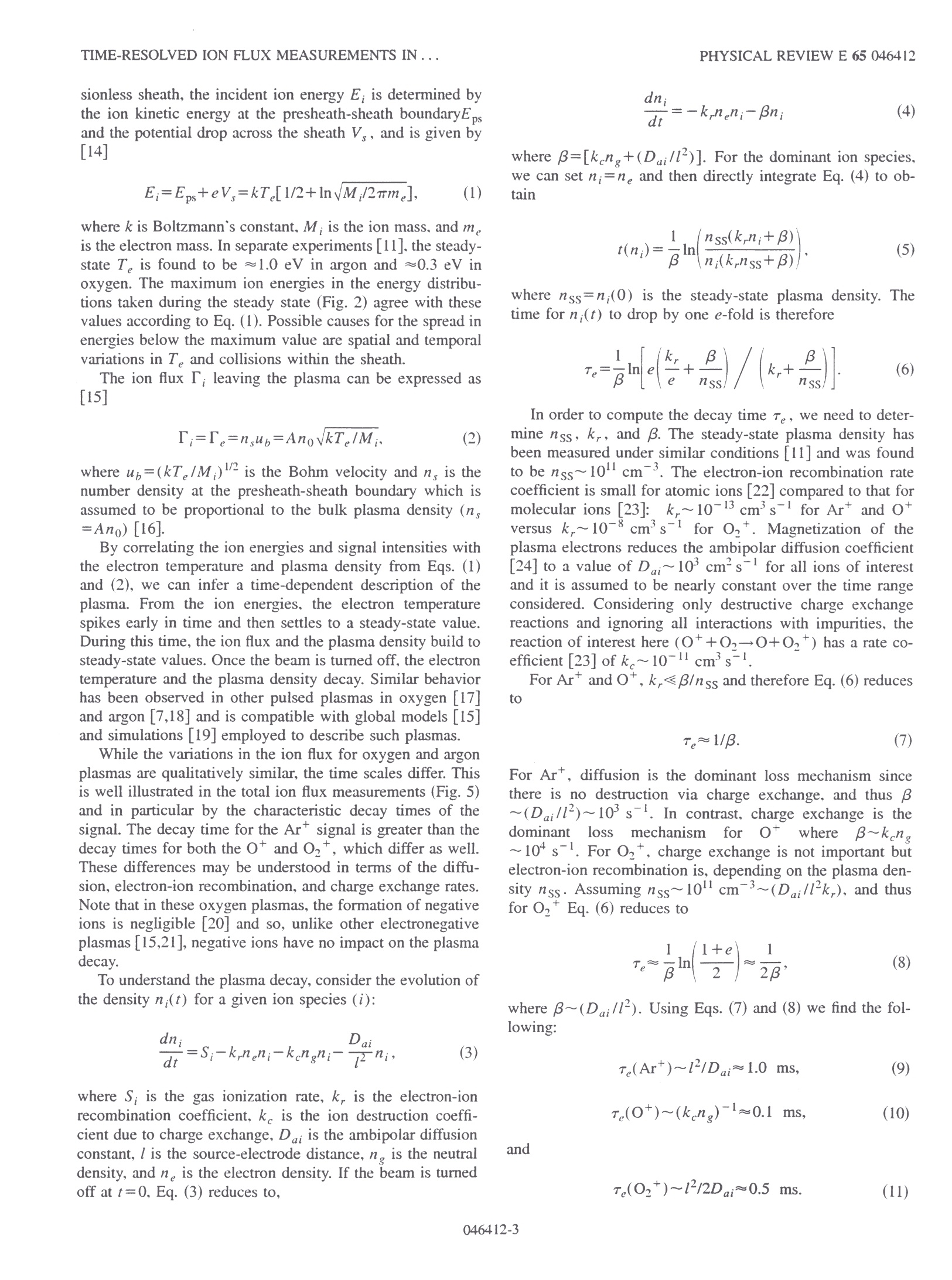
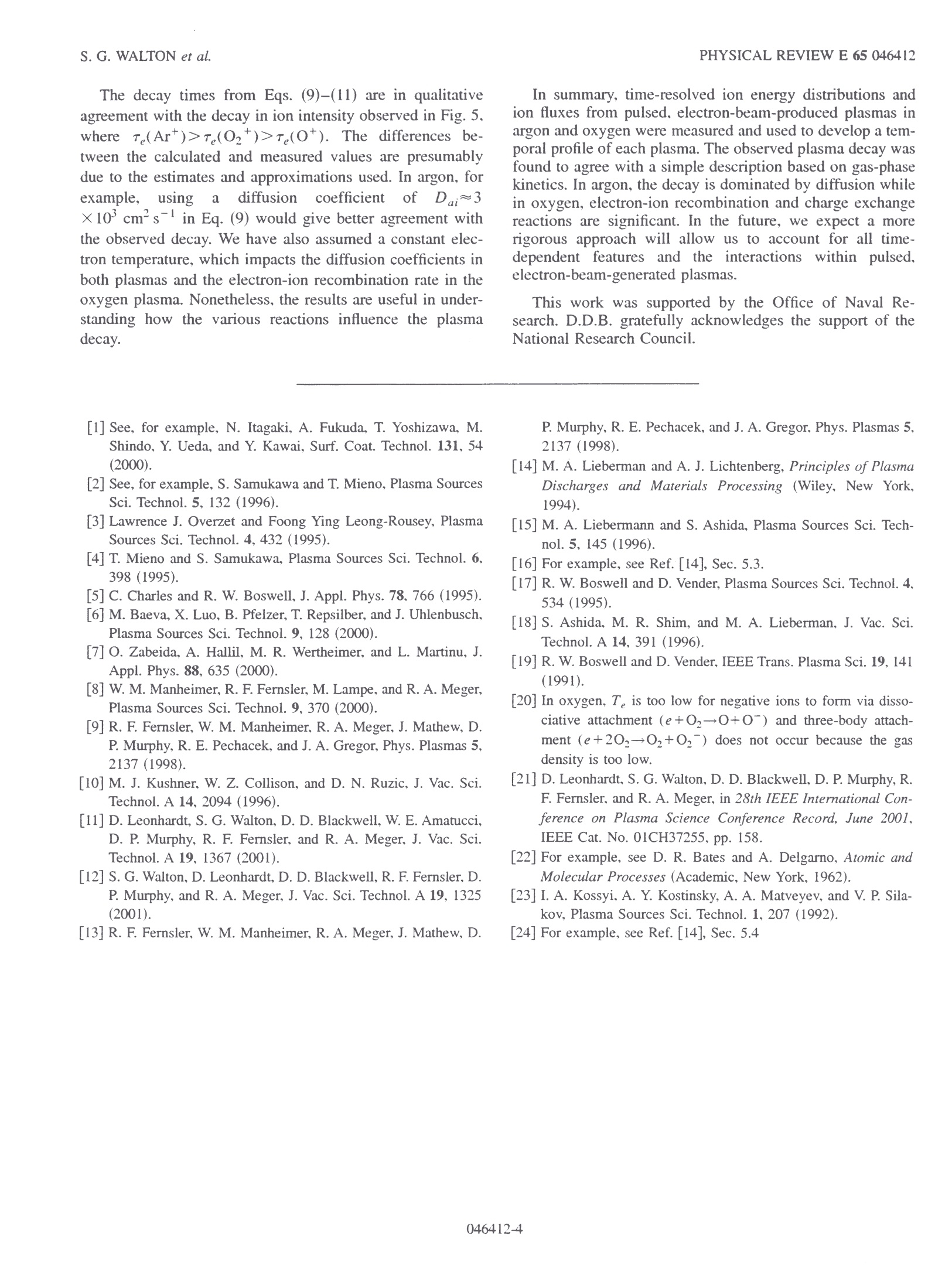
还剩1页未读,是否继续阅读?
北京英格海德分析技术有限公司为您提供《脉冲电子束产生的等离子体的时间分辨离子通量分析》,该方案主要用于其他中--检测,参考标准--,《脉冲电子束产生的等离子体的时间分辨离子通量分析》用到的仪器有EQP等离子体质量和能量分析质谱仪
推荐专场
相关方案
更多










